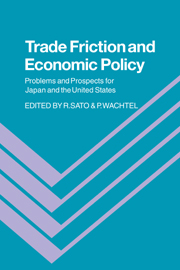Book contents
- Frontmatter
- Contents
- Foreword by Richard R. West
- Preface
- List of contributors
- 1 Introduction
- Part I Sources of trade friction
- 2 Restructuring the Japanese economy from a global perspective
- 3 Is the Japan problem over?
- 4 The Japanese–U.S. trade friction: some perspectives from the Japanese business community
- 5 Industrial policy in Japan: overview and evaluation
- Part II Macroeconomic policy
- Part III Trade policy
- Index
2 - Restructuring the Japanese economy from a global perspective
Published online by Cambridge University Press: 05 February 2012
- Frontmatter
- Contents
- Foreword by Richard R. West
- Preface
- List of contributors
- 1 Introduction
- Part I Sources of trade friction
- 2 Restructuring the Japanese economy from a global perspective
- 3 Is the Japan problem over?
- 4 The Japanese–U.S. trade friction: some perspectives from the Japanese business community
- 5 Industrial policy in Japan: overview and evaluation
- Part II Macroeconomic policy
- Part III Trade policy
- Index
Summary
Trade friction between Japan and the United States is an obvious fact. What is far less obvious is how each nation will address this problem. In this chapter, I would like to discuss how Japan proposes to alleviate the trade friction that has resulted from an enormous Japanese surplus on its current account and a correspondingly enormous U.S. current account deficit.
In addressing this problem, one is at first confronted by its sheer enormity. How are we to deal with the huge external imbalances facing the global economy today? How can we literally restructure the Japanese economy in a manner that will alleviate international friction while preserving domestic tranquility? Japan's approach to this admittedly large and complex issue has been three-fold. First, efforts, must be made to improve market access and increase domestic demand. Second, exchange rate realignment should be implemented. And finally, efforts must be made to restructure Japanese industry along more productive lines by gradually shrinking economically depressed industries.
In the course of the past year, important and encouraging developments have already occurred on the world economic scene. Cooperative efforts to realign exchange rates have been more or less successfully implemented, interest rates have declined, and new initiatives to address the debt situation have emerged. A series of measures have been adopted by Japan to improve market access and expand domestic demand, and European efforts to redress structural rigidities are at least being discussed. Finally, recent oil price declines are also considered to have beneficial effects in general, although the full impact on oil-producing and debtor countries is yet to be assessed.
- Type
- Chapter
- Information
- Trade Friction and Economic PolicyProblems and Prospects for Japan and the United States, pp. 11 - 15Publisher: Cambridge University PressPrint publication year: 1987



